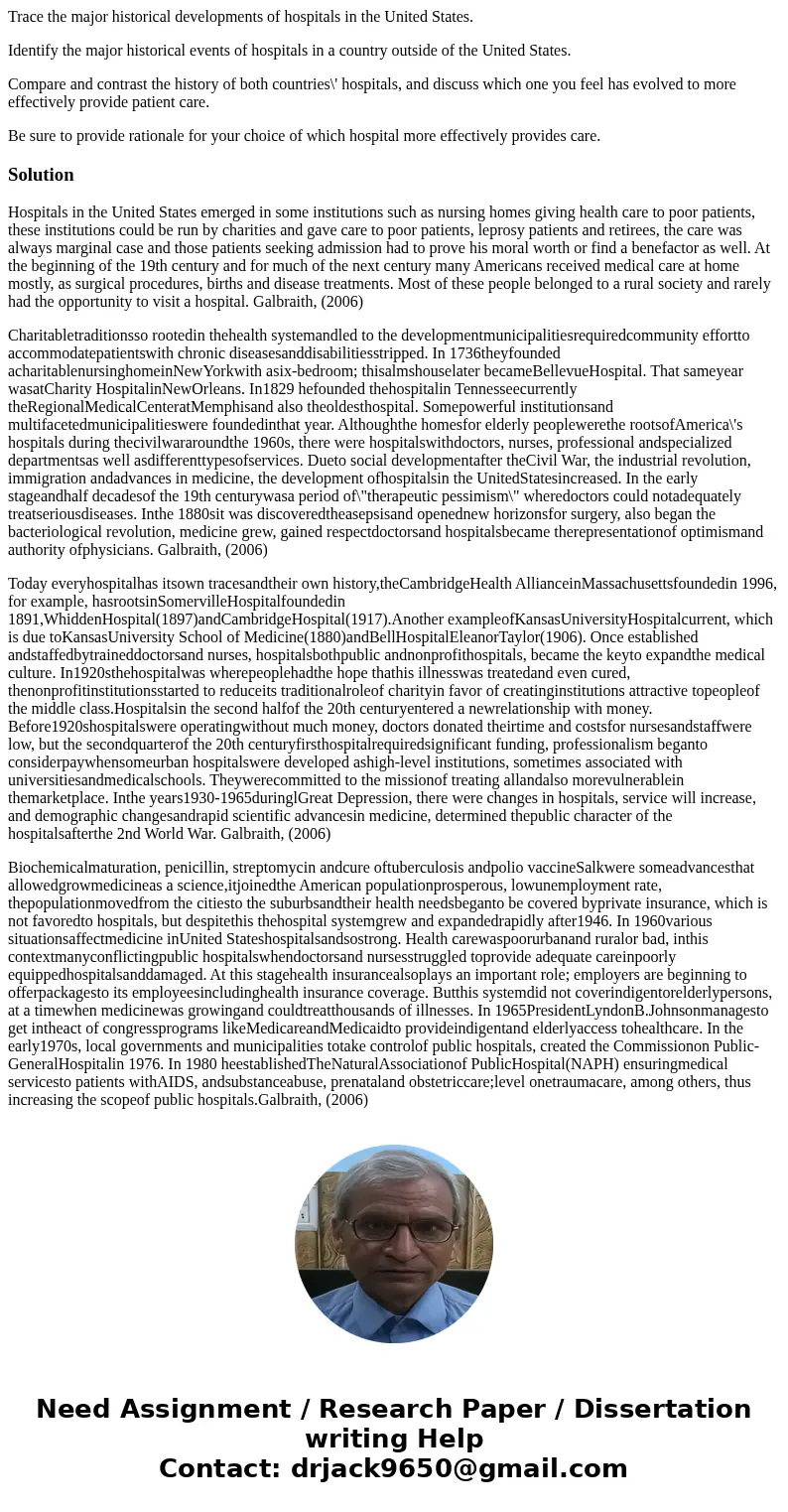Trace the major historical developments of hospitals in the
Trace the major historical developments of hospitals in the United States.
Identify the major historical events of hospitals in a country outside of the United States.
Compare and contrast the history of both countries\' hospitals, and discuss which one you feel has evolved to more effectively provide patient care.
Be sure to provide rationale for your choice of which hospital more effectively provides care.
Solution
Hospitals in the United States emerged in some institutions such as nursing homes giving health care to poor patients, these institutions could be run by charities and gave care to poor patients, leprosy patients and retirees, the care was always marginal case and those patients seeking admission had to prove his moral worth or find a benefactor as well. At the beginning of the 19th century and for much of the next century many Americans received medical care at home mostly, as surgical procedures, births and disease treatments. Most of these people belonged to a rural society and rarely had the opportunity to visit a hospital. Galbraith, (2006)
Charitabletraditionsso rootedin thehealth systemandled to the developmentmunicipalitiesrequiredcommunity effortto accommodatepatientswith chronic diseasesanddisabilitiesstripped. In 1736theyfounded acharitablenursinghomeinNewYorkwith asix-bedroom; thisalmshouselater becameBellevueHospital. That sameyear wasatCharity HospitalinNewOrleans. In1829 hefounded thehospitalin Tennesseecurrently theRegionalMedicalCenteratMemphisand also theoldesthospital. Somepowerful institutionsand multifacetedmunicipalitieswere foundedinthat year. Althoughthe homesfor elderly peoplewerethe rootsofAmerica\'s hospitals during thecivilwararoundthe 1960s, there were hospitalswithdoctors, nurses, professional andspecialized departmentsas well asdifferenttypesofservices. Dueto social developmentafter theCivil War, the industrial revolution, immigration andadvances in medicine, the development ofhospitalsin the UnitedStatesincreased. In the early stageandhalf decadesof the 19th centurywasa period of\"therapeutic pessimism\" wheredoctors could notadequately treatseriousdiseases. Inthe 1880sit was discoveredtheasepsisand openednew horizonsfor surgery, also began the bacteriological revolution, medicine grew, gained respectdoctorsand hospitalsbecame therepresentationof optimismand authority ofphysicians. Galbraith, (2006)
Today everyhospitalhas itsown tracesandtheir own history,theCambridgeHealth AllianceinMassachusettsfoundedin 1996, for example, hasrootsinSomervilleHospitalfoundedin 1891,WhiddenHospital(1897)andCambridgeHospital(1917).Another exampleofKansasUniversityHospitalcurrent, which is due toKansasUniversity School of Medicine(1880)andBellHospitalEleanorTaylor(1906). Once established andstaffedbytraineddoctorsand nurses, hospitalsbothpublic andnonprofithospitals, became the keyto expandthe medical culture. In1920sthehospitalwas wherepeoplehadthe hope thathis illnesswas treatedand even cured, thenonprofitinstitutionsstarted to reduceits traditionalroleof charityin favor of creatinginstitutions attractive topeopleof the middle class.Hospitalsin the second halfof the 20th centuryentered a newrelationship with money. Before1920shospitalswere operatingwithout much money, doctors donated theirtime and costsfor nursesandstaffwere low, but the secondquarterof the 20th centuryfirsthospitalrequiredsignificant funding, professionalism beganto considerpaywhensomeurban hospitalswere developed ashigh-level institutions, sometimes associated with universitiesandmedicalschools. Theywerecommitted to the missionof treating allandalso morevulnerablein themarketplace. Inthe years1930-1965duringlGreat Depression, there were changes in hospitals, service will increase, and demographic changesandrapid scientific advancesin medicine, determined thepublic character of the hospitalsafterthe 2nd World War. Galbraith, (2006)
Biochemicalmaturation, penicillin, streptomycin andcure oftuberculosis andpolio vaccineSalkwere someadvancesthat allowedgrowmedicineas a science,itjoinedthe American populationprosperous, lowunemployment rate, thepopulationmovedfrom the citiesto the suburbsandtheir health needsbeganto be covered byprivate insurance, which is not favoredto hospitals, but despitethis thehospital systemgrew and expandedrapidly after1946. In 1960various situationsaffectmedicine inUnited Stateshospitalsandsostrong. Health carewaspoorurbanand ruralor bad, inthis contextmanyconflictingpublic hospitalswhendoctorsand nursesstruggled toprovide adequate careinpoorly equippedhospitalsanddamaged. At this stagehealth insurancealsoplays an important role; employers are beginning to offerpackagesto its employeesincludinghealth insurance coverage. Butthis systemdid not coverindigentorelderlypersons, at a timewhen medicinewas growingand couldtreatthousands of illnesses. In 1965PresidentLyndonB.Johnsonmanagesto get intheact of congressprograms likeMedicareandMedicaidto provideindigentand elderlyaccess tohealthcare. In the early1970s, local governments and municipalities totake controlof public hospitals, created the Commissionon Public-GeneralHospitalin 1976. In 1980 heestablishedTheNaturalAssociationof PublicHospital(NAPH) ensuringmedical servicesto patients withAIDS, andsubstanceabuse, prenataland obstetriccare;level onetraumacare, among others, thus increasing the scopeof public hospitals.Galbraith, (2006)
Thecountry with whichI would like tocomparethe developmentof hospitals isCuba, the occupation ofCubaby the Spanishoccurredin 1509, the islandhad about100,000inhabitantsat the time,the majorityof doctors inCubawere ofSpanishorigin, formedtheuniversity ofSalamancain Spain, andhad to passan examination beforethe RoyalCourtofProtomedicatoto legalizemedical practice. InCubain 1711was establishedas the third inAmericawheredoctorsgraduatedsomedegree.Inthe eighteenth century wasfounded the Universityof Havana andin 1728the medical college, which formalizedmedical studiesin the country. Thehospital developmentwas done inconjunction withthe development and establishmentofthe Cuban population, the first villageswerefoundedin 1511BaracoaandBayamoin 1513, the town of SanCristobalde LaHabanawas foundeda littlelater,but the developmentwasincreasedby its geographical location, the marinapatientsandSpanish militarytroopswere servedandtreatedfordiseasesinnursingBelen. In 1738there is anepidemicof yellow fever,andwas enabledtomarinehospitalin a houseof the Bishop, withcapacity for 360patientsandat the same timehad foundedone of the firstpublichospitalSanJuan de Dios, foundedin 1761byanother hospital “SanCarlosde laCaridad”, which was closeda year laterduring theBritishinvasionto Havana. In 1780 hebuilt ahospitalforsailorswith threeroomsand has capacity for470 patients.Inthe 1800sandhadseveralwell-organizedhospitals, medicalstaff, nursesand hospital staff, includingamphitheatersforanatomy. Between 1817and1834 itfounded thewomen\'s hospitaland thehospitalofSanLazaroattendingleprosy patients, vaccination servicesare establishedby the presenceof smallpox inships comingto the islandfrom the Canary Islandsand from the UnitedStates.Charityhouseswere builtfor children, womenwith mental disordersand beggars. Also emergedpharmacies,surgerybegan todevelopwith the same limitationsofthe historyof surgery ineach country.Delgado, (2010)
Itbegan to opennew hospitalsindifferent provincesinthe sameextent thatthe populationwasgrowing.Duringthemid-19th centuryandearly 20th centuryCuban medicineWasdeveloping inline withthe developmentof medicineworldwide,wereemerginghealth institutionsappearedmore technological developmentandnewdiscovery andcure formany diseases. For manyyearsthe medicinein the countrywas deprivedin many hospitals andprivate clinics, public hospitalssubsidized bythe governmenthadbadhygiene andmedical attentionafter 1959establishingsocial medicine inCuba, both the Governorestablishes a system ofprimary careor social-preventive, secondary carehospitalsand institutesoftertiary care.Itguarantees access tothe entire Cuban populationto medical careat no cost,includingemergency services, surgery; drugs are soldat low prices,accessible to all.Inthe 1990safter the fallof the socialistthe qualityof hospitals, equipment, technologyand evenhealth care,are decreasing, despite the country devotesmuch ofits annual budget tosocial medicine, andflyinglow ratesinfant mortality andlife expectancyat birthis 77yearsCubans, the question isare theindicesthat showreal? Thecountry\'s poverty rate increasedsignificantlyin recent years, theaverageCubansalaryis low, if we applythe concept of health; I think the physical, mentaland social development ofCubais far fromachieved. When we comparethedevelopment of medicineand hospitalsbetween the U.S. andCubaare thingsthat contrastas accessibilityto medical servicesforthe disadvantaged, for example, inCuba, butundoubtedly thequality of servicesis better inUnitedStates, andthe newhealthreformssuch as Medicare andObama- carepoint tomorecoverage andaccess for peopleDelgado, (2005)
References:


 Homework Sourse
Homework Sourse